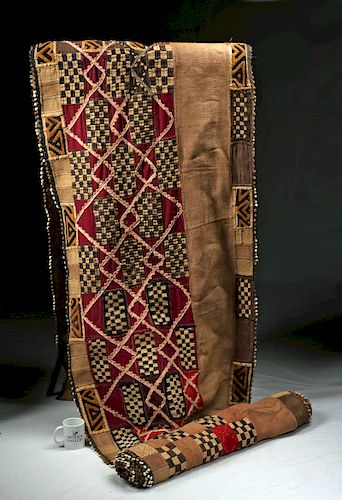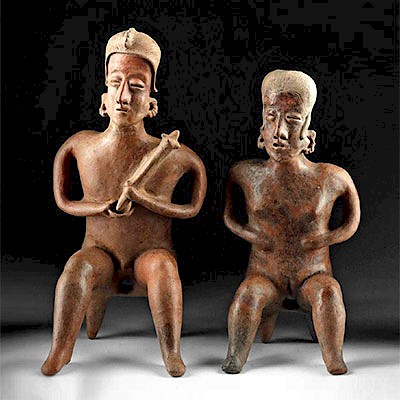African Kuba Raffia & Cowrie Shell Dance Skirt - 1950s
Lot 158a
About Seller
Artemis Gallery
686 S Taylor Ave, Ste 106
Louisville, CO 80027
United States
Selling antiquities, ancient and ethnographic art online since 1993, Artemis Gallery specializes in Classical Antiquities (Egyptian, Greek, Roman, Near Eastern), Asian, Pre-Columbian, African / Tribal / Oceanographic art. Our extensive inventory includes pottery, stone, metal, wood, glass and textil...Read more
Estimate:
$4,000 - $5,000
Absentee vs Live bid
Two ways to bid:
- Leave a max absentee bid and the platform will bid on your behalf up to your maximum bid during the live auction.
- Bid live during the auction and your bids will be submitted real-time to the auctioneer.
Bid Increments
| Price | Bid Increment |
|---|---|
| $0 | $25 |
| $300 | $50 |
| $1,000 | $100 |
| $2,000 | $250 |
| $5,000 | $500 |
| $10,000 | $1,000 |
| $20,000 | $2,500 |
| $50,000 | $5,000 |
| $100,000 | $10,000 |
| $200,000 | $20,000 |
About Auction
By Artemis Gallery
May 23, 2019
Set Reminder
2019-05-23 10:00:00
2019-05-23 10:00:00
America/New_York
Bidsquare
Bidsquare : Exceptional Day 2 Ethnographic Tribal Fossils
https://www.bidsquare.com/auctions/artemis-gallery/exceptional-day-2-ethnographic-tribal-fossils-4136
Day 2 of an important 2-day auction featuring exceptional ethnographic art from around the world. Today's sale will feature Pre-Columbian from the ancient americas, Native American, African / Tribal, Oceanic, Spanish Colonial, and incredible Fossils. Artemis Gallery info@artemisgallery.com
Day 2 of an important 2-day auction featuring exceptional ethnographic art from around the world. Today's sale will feature Pre-Columbian from the ancient americas, Native American, African / Tribal, Oceanic, Spanish Colonial, and incredible Fossils. Artemis Gallery info@artemisgallery.com
- Lot Description
Africa, Democratic Republic of Congo, ca. 1950. A traditional Kuba dance skirt (Tcaka) - handmade from raffia and hand-stitched with immense artistry, presenting bold geometric patterns in warm earth tones - rich browns and toasty almond beiges - as well as pops of more vibrant color - magenta, blue, green, and pink. Such cloths are usually created by Kuba men on a single heddle loom. Next they are embroidered by women and children to create an uncut or cut-pile appearance. Highly decorative and created with painstaking technique, this skirt presents panels of checkerboard patterns and an applied overlapping zigzag/diamond motif comprised of pink, black, and houndstooth fabrics. The trim is made of alternating passages of cut raffia pom poms and cowrie shells. A particularly exceptional example given that it is made of raffia, demonstrates immense artistry with intricate patterns, skillfully executed weaving, beautiful hues, and also boasts a generous size and excellent condition. Size: 260" L x 33" H (660.4 cm x 83.8 cm)
Kuba cloths are worn during ceremonial events, especially funerals; however, they are also found in tapestries and home furnishings. The abstract geometric patterns are symbolic of an individual's social and marital status, age, and/or personal attributes or character.
There are several theories concerning the inspiration for Kuba style. One theory suggests that the designs in Kuba textiles are rooted in tribal scarification patterns. Another suggests that the motifs of Kuba textiles were modeled upon those found in crop patterns. Still another suggests that the source for their visual patterns was divine intervention. The creation of these ceremonial wraps is a collaborative effort. Men are involved in all stages of preparing the fiber and executing the weaving, whereas women soften the textiles and apply the decoration. These coveted ceremonial textiles are worn during ritual dances and special occasions such as festivals, weddings, funerals, and initiation rites.
Provenance: private Poos collection, Overland Park, Kansas, USA - One of the largest privately held quilt and textile collections in the world, the Poos Collection has evolved over 50 years and through extensive travels to allow for original or point of source acquisition. The collection includes international textiles and garments with an emphasis on West African textiles such as adire, aso oke, kente, and ewe woven prestige cloths. This piece was purchased from African Trading Port 2012.
All items legal to buy/sell under U.S. Statute covering cultural patrimony Code 2600, CHAPTER 14, and are guaranteed to be as described or your money back.
A Certificate of Authenticity will accompany all winning bids.
We ship worldwide and handle all shipping in-house for your convenience.
#145907One short length of trim has separated from the body of the piece but easily could be reattached. A few small holes in the raffia sections and some of the fibers have stretched/separated a bit due to use and age. A couple of small old repairs. Still well-preserved overall.Condition
- Shipping Info
-
All shipping is handled in-house for your convenience. Your invoice from Artemis Gallery will include shipping calculation instructions. If in doubt, please inquire BEFORE bidding for estimated shipping costs for individual items.
-
- Buyer's Premium



 EUR
EUR CAD
CAD AUD
AUD GBP
GBP MXN
MXN HKD
HKD CNY
CNY MYR
MYR SEK
SEK SGD
SGD CHF
CHF THB
THB















